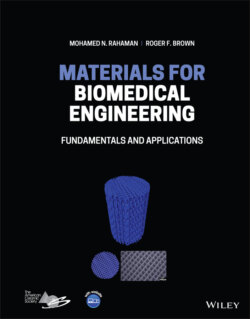Читать книгу Materials for Biomedical Engineering - Mohamed N. Rahaman - Страница 89
Crystal Structure of Hydroxyapatite
ОглавлениеSeveral types of synthetic calcium phosphate materials have been studied or developed for use in biomedical applications such as bone reconstruction, drug delivery devices and coatings for metal prostheses (Chapter 7). Implants composed of hydroxyapatite, with the formula Ca10(PO4)6(OH)2, β‐tricalcium phosphate, Ca3(PO4)2, and a two‐phase mixture called biphasic calcium phosphate (BCP), composed of varying ratios of hydroxyapatite and β‐tricalcium phosphate, for example, have been used for decades in healing bone defects. The primary building block of β‐tricalcium phosphate and hydroxyapatite is the phosphate ion (PO4)3− in which the phosphorus and oxygen atoms form a slightly distorted tetrahedron (Figure 3.10a). As the main inorganic (mineral) constituent of hard tissues such as bone and teeth is composed of a material that resembles hydroxyapatite, considerable attention has been devoted to the structure and properties of this material. Hydroxyapatite exists in a monoclinic or a hexagonal crystal structure. The unit cell in the hexagonal structure has dimensions a = b = 0.9430 nm and c = 0.6891 nm, and bond angles α = β = 90° and γ = 120°, and it is composed of 6 (PO4)3− ions surrounded by 10 calcium ions and with 2 hydroxyl (OH)− ions along the c‐axis (Figure 3.10b).
Figure 3.10 (a) Arrangement of atoms in a phosphate (PO4)3− ion; (b) arrangement of atoms (ions) in unit cell of hydroxyapatite.
The name hydroxyapatite refers to a crystalline material with the stoichiometric composition Ca10(PO4)6(OH)2. In comparison, the inorganic constituent of hard tissues such as bone and teeth is not pure hydroxyapatite. Instead, it has a composition that deviates from this stoichiometric composition to varying extent, depending on the living organism and the location of the hard tissue in the organism. The host ions in hydroxyapatite are substituted by small to trace amounts of other ions, such as (CO3)2−, (HPO4)2−, Mg2+, Na+, Sr2+, K+, and F− (Section 3.4.1). This substituted composition, is one factor that contributes to the unique properties of the hydroxyapatite‐like material of bone. As the properties of a material are dependent on its composition, there has been significant interest in producing synthetic hydroxyapatite‐like materials with compositions that approximate the inorganic constituent of bone (Chapter 7).
